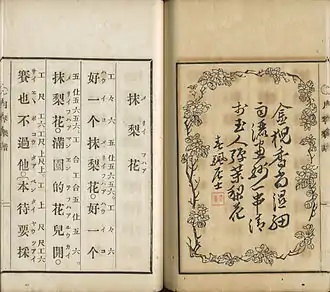| "Mo Li Hua" | |
|---|---|
| Song | |
| Language | Chinese |
| Genre | Folk |
| Length | Around 2–3 minutes |
| Songwriter(s) | unknown |

Mo Li Hua (Chinese: 茉莉花; pinyin: Mòlìhuā or Mòlihuā[a][1]; lit. 'Jasmine Flower'[b]) is a Chinese folk song from the Jiangnan region.[2][3][4] The song dates back to the 18th century. Over time, many regional variations were created, and the song gained popularity both in China and abroad.
It has been used during events such as 2004 Summer Olympics, 2008 Summer Olympics and 2010 Shanghai Expo opening ceremony, and during the 2011 Chinese pro-democracy protests.[5][6][7]
History and popularity

It was created during the Qianlong era (1735–1796) of the Qing dynasty.[2] There are several regional versions of the song,[8][9]: 84– with different lyrics and melody.[10]: 46– One version of the song describes a custom of giving jasmine flowers, popular in the southern Yangtze delta region of China.[2] Another, longer version describes the fear of plucking the flower.[10]: 46– [9]: 81–82 It has been played on ancient metal bells (bianzhong) and modern jade chimes.[4] It uses the five note (pentatonic) scale ubiquitous in Chinese music. The tune is one of xiaodiao ("short tunes"), popular in Chinese urban areas.[11] In 1804 a British diplomat, John Barrow, noted that the tune seems to be one of the most popular songs in China.[9]: 84–
The song became one of the first Chinese folk songs to become widely known outside China.[9]: 81–82 In 1896 the song was used as temporary national anthem by the Qing Chinese officials in Europe. The melody has become well known among Western listeners as it was used by Giacomo Puccini in his opera Turandot (1926), boy choir air "Là, sui monti dell'est", where it is associated with 'Turandot's splendor'.[2][4][12][13] It appeared in a 1937 Hollywood movie The Good Earth (based on a novel by Pearl S. Buck).[14]: 51– It has been adapted by many artists around the world, for example by Kenny G.[9]: 84– In 1982 the song found a place on a UNESCO list of recommended songs.[9]: 84– When China regained sovereignty of Macau and Hong Kong, in 1999 and 1997, respectively, this music was played in the ceremonies. The song was said to be a favorite of the former General Secretary of the Chinese Communist Party, Jiang Zemin (it was at his request that the song was played during the transfer ceremony in Hong Kong).[7] The tune was played during Central Committee of the Chinese Communist Party meetings.[15]
This song was sung partially unaccompanied by a young Chinese girl, and partially accompanied by the music by Peking University students (whose version has been described as infused with a techno beat) and broadcast to the world at the closing ceremonies of the 2004 Summer Olympics in Athens, Greece, to introduce the next Olympic Games site.[2][16] An adaptation of the melody by Tan Dun and Wang Hesheng, chosen from more than 4,000 pieces, was played during the medal ceremonies at the Beijing 2008 Olympic Games.[4] It was also performed at the 2010 Shanghai Expo opening ceremony by an orchestra with the pianist Lang Lang.
Zhao Dongming, head of Beijing Organizing Committee for the Olympic Games's culture and ceremonies department, commented that "This piece of music reminds you of the gold medals for the Beijing Olympics, which are made of gold and jade".[4] This piece of Tan Dun, an Academy Award winning Chinese contemporary classical composer, cited by China Daily in 2008, described it as "glorious, heartwarming and full of respect... an iconic piece... almost a cultural symbol of China" and "From Puccini to the Beijing Olympics, this melody is a gift from the Chinese people to the world's athletes".[4] In 2009 Russian singer Vitas, during the Chinese premiere of his program Sleepless Night, at least has also performed Mo Li Hua (never included in digital download until then).[17]
During the 2011 Chinese pro-democracy protests, as organizers instructed protesters to play Mo Li Hua on their cell phones as a form of antigovernment protest.[5] The song was placed on authorities' list of online censored materials.[5] Videos of the song, including at least one from an official event (a 2006 Kenyan students welcome for Chinese president Hu Jintao), were removed from Chinese websites, and searches for the song's name were blocked.[3] The censorship attracted widespread attention and was difficult because of the popularity of the song and its association with Chinese culture and history.[6][7] At least one new version of the song, mentioning fear of arrests, has been developed by the activists as a response.[6][18]
In 2013, international superstar Celine Dion performed the song in Mandarin on Chinese state TV as part of its New Year Gala show welcoming in the Lunar New Year. She sang in a duet with Chinese soprano Song Zuying.[19]
Since 2018, Kazakh singer Dimash Qudaibergen has performed this song in Mandarin on four occasions, three years in a row, during New Year and Chinese New Year celebration galas on various TV stations[20] including a duet with vocalist Luo Tianyi on 23rd January 2020.[21]
Lyrics
There are several versions of the song, with different lyrics and melody.
First variant
One of the popular versions lyrics goes:
Traditional Chinese好一朵美麗的茉莉花 Simplified Chinese好一朵美丽的茉莉花 PinyinHǎo yī duǒ měilì de mòlihuā
|
Literal translation fitting musicWhat a pretty Jasmine flower, Poetic translationFlower of jasmine, so fair! Literary translationWhat a Jasmine Brimming with Beauty[22] English version sing-alongHǎo yī duǒ měi lì de mò li huā |

Second variant
Another popular versions' lyrics, with three strophes:[10]: 46–
Traditional Chinese好一朵茉莉花, 好一朵茉莉花, 好一朵茉莉花, Simplified Chinese好一朵茉莉花, 好一朵茉莉花, 好一朵茉莉花, |
Hanyu PinyinHǎo yī duo mòlìhuā, Literal translationWhat a jasmine flower! What a jasmine flower! What a jasmine flower! |
See also
- Jasminum sambac, the species of jasmine the song is based on.
- Music of China
Notes
a The song has been mistakenly titled as 抹梨花, which is pronounced the same.
b Though most commonly known in English as the Jasmine Flower, the title has also been translated as Beautiful Jasmine Flower[3] or Such a Beautiful Jasmine.[5] It has also been transliterated as Mo Li Hua,[8] Mo-Li Hua,[12] Moli Hua[14]: 83– and Molihua.[4]
References
- ↑ "教育部《國語辭典簡編本》2021".
- 1 2 3 4 5 Chen, Qian (21 July 2008). "'Jasmine Flower' chosen for medal ceremony music". Shanghai Daily. Archived from the original on 16 July 2011. Retrieved 18 November 2008.
- 1 2 3 "Jasmine stirrings in China: No awakening, but crush it anyway: The government goes to great lengths to make sure all is outwardly calm", 3 March 2011
- 1 2 3 4 5 6 7 "Classical piece will ring in ears of winners". China Daily.
- 1 2 3 4 Clem, Will (3 March 2011). "The flowering of an unconventional revolution". South China Morning Post. Hong Kong. Archived from the original on 5 March 2011. Retrieved 3 March 2011.
- 1 2 3 "Kenny G and Hu Jintao Make Protest Music: Tunisia's Choice of Revolutionary Symbols Confounds Chinese Censors", Slate
- 1 2 3 Ian Johnson, "Calls for a 'Jasmine Revolution' in China Persist", The New York Times, 23 February 2011
- 1 2 Yayoi Uno Everett; Frederick Lau (2004). Locating East Asia in Western art music. Wesleyan University Press. pp. 276–. ISBN 978-0-8195-6662-1. Retrieved 17 March 2011.
- 1 2 3 4 5 6 Jie Jin (31 March 2011). Chinese Music. Cambridge University Press. ISBN 978-0-521-18691-9. Retrieved 17 March 2011.
- 1 2 3 Hong Zhang; Zu-yan Chen; Robert Daly (January 2001). Chinese Through Song. Global Academic Publishing. ISBN 978-1-58684-122-5. Retrieved 17 March 2011.
- ↑ Alan Robert Thrasher (2008). Sizhu instrumental music of South China: ethos, theory and practice. BRILL. pp. 116–. ISBN 978-90-04-16500-7. Retrieved 17 March 2011.
- 1 2 William Ashbrook; Harold Powers (1991). Puccini's Turandot: The End of the Great Tradition. Princeton University Press. p. 90. ISBN 978-0-691-02712-8. Retrieved 17 March 2011.
- ↑ Burton D. Fisher (1 June 2004). Opera Classics Library Puccini Companion: The Glorious Dozen. Opera Journeys Publishing. pp. 696–. ISBN 978-1-930841-62-8. Retrieved 17 March 2011.
- 1 2 Peter M. Chang (28 February 2006). Chou Wen-Chung: the life and work of a contemporary Chinese-born American composer. Scarecrow Press. ISBN 978-0-8108-5296-9. Retrieved 17 March 2011.
- ↑ Robert Lawrence Kuhn (14 July 2009). How China's leaders think: the inside story of China's reform and what this means for the future. John Wiley and Sons. pp. 339–. ISBN 978-0-470-82445-0. Retrieved 17 March 2011.
- ↑ Monroe Edwin Price (28 February 2008). Owning the Olympics: narratives of the new China. University of Michigan Press. pp. 202–. ISBN 978-0-472-05032-1. Retrieved 17 March 2011.
- ↑ Vitas' official site. Archived 22 May 2011 at the Wayback Machine
- ↑ "YouTube – Muo Li Hua – The Jasmine Flower". YouTube. 6 March 2011. Archived from the original on 6 March 2011.
- ↑ "Celine Dion's Chinese New Year song". BBC News.
- ↑ "Dimash – Jasmine (茉莉花) the Sing New Era CCTV3". YouTube.
- ↑ "Dimash and Luo Tianyi (洛天依) – Jasmine". YouTube.
- ↑ "歌曲英译- 好一朵美丽的茉莉花_新浪博客". Sina Corp.